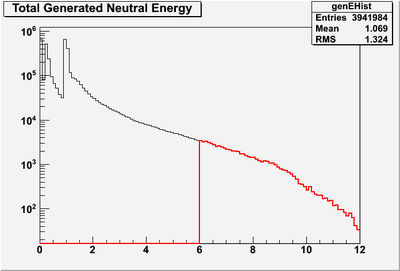Difference between revisions of "Reconstruction, May 26, 2009"
From GlueXWiki
(→bggen output:) |
(→filter_HighE) |
||
| Line 63: | Line 63: | ||
== filter_HighE == | == filter_HighE == | ||
#Apply 6GeV cut to bggen events | #Apply 6GeV cut to bggen events | ||
| − | #3941984 events processed -> 66056 events written to filtered.hddm | + | #3941984 events processed -> 66056 events written to filtered.hddm '''(1.68%)''' |
[[Image:Totalneutralenergy.png |400px]] | [[Image:Totalneutralenergy.png |400px]] | ||
== Submit filtered bggen == | == Submit filtered bggen == | ||
Revision as of 23:50, 25 May 2009
Time: 11:00 EST/10:00 CST
- See GlueX Communications for detailed instructions
- Backup Plan: ESNET Number 8542553
Contents
Reconstruction To Do List
- Generation
- Use genr8 for a2 production
- Skim off (hd_filter) the wanted events by cutting on the total neutral energy (> 6 GeV) but record the total number of events before skimming. The resulting MC data set will be stored for general use.
- Use Pythia for background generation after removing a2 → η π0 from the MC data stream
- Use a2 charge exchange production xsection vs pythia total xsection to estimate number of signal and noise events
- Analysis
- After pruning the Pythia events, check the generated vs. reconstructed energy in a plot.
- Look at the a2 mass peak - adjust cuts on the eta and pi0 masses then look at the effect on the different angular distributions (i.e. Gottfried-Jackson angles, etc.)
- look at difference between reconstructed and generated z position for less than 65 cm
- look at single photon reconstruction efficiencies
- adjust the error matrix for the BCAL (look in PID/DPhoton_factory.cc)
- Gather all relevant DocDB documents and cross section publications at one spot on the Wiki.
Documents to Review
- Simultaneous Photoproduction of eta and pi0 Mesons on the Proton, PRL 100, 052003 (2008) DOI:10.1103/PhysRevLett.100.052003
- Pertinence:
- Abstract: The analysis of the γp → η π0 p reaction has been performed using data from the GRAAL experiment. The total and differential cross sections and the beam asymmetry have been obtained from threshold up to 1.5 GeV of beam energy. The two resonances S11(1535) and Δ(1700) are expected to be excited in the intermediate states of this reaction. The results are used to test predictions based on the assumption that both resonances are dynamically generated from the meson-baryon interaction provided by chiral Lagrangians. The term involving the Δ(1700) excitation, followed by the decay into ηΔ(1232), is found to be dominant.
Tentative Agenda
- Review Reconstruction Plans in list above
- a2 cross section papers
- bggen and Pythia
- Discussion
- Blake's trip to Indiana (flights booked for June 21st-27th)
bggen output:
===================================================================================== Events Simulated: 3950000 Reference interaction rate: 398.07 kHz process events fraction range -------------------------------------------------------------------------------------
0 PYTHIA 824047 20.9 % 3.00<E<12.00 GeV -------------------------------------------------------------------------------------
1 p pi0 875152 22.2 % 0.15<E< 3.00 GeV
2 n pi+ 1164773 29.5 %
3 p pi+ pi- 131397 3.3 %
4 p rho0 99770 2.5 %
5 Delta++ pi- 270440 6.8 %
6 p pi0 pi0 67776 1.7 %
7 n pi+ pi0 319920 8.1 %
8 p eta 24689 0.6 %
9 p pi+ pi- pi0 127655 3.2 %
10 n pi+ pi+ pi- 44381 1.1 %
-------------------------------------------------------------------------------------
filter_HighE
- Apply 6GeV cut to bggen events
- 3941984 events processed -> 66056 events written to filtered.hddm (1.68%)
